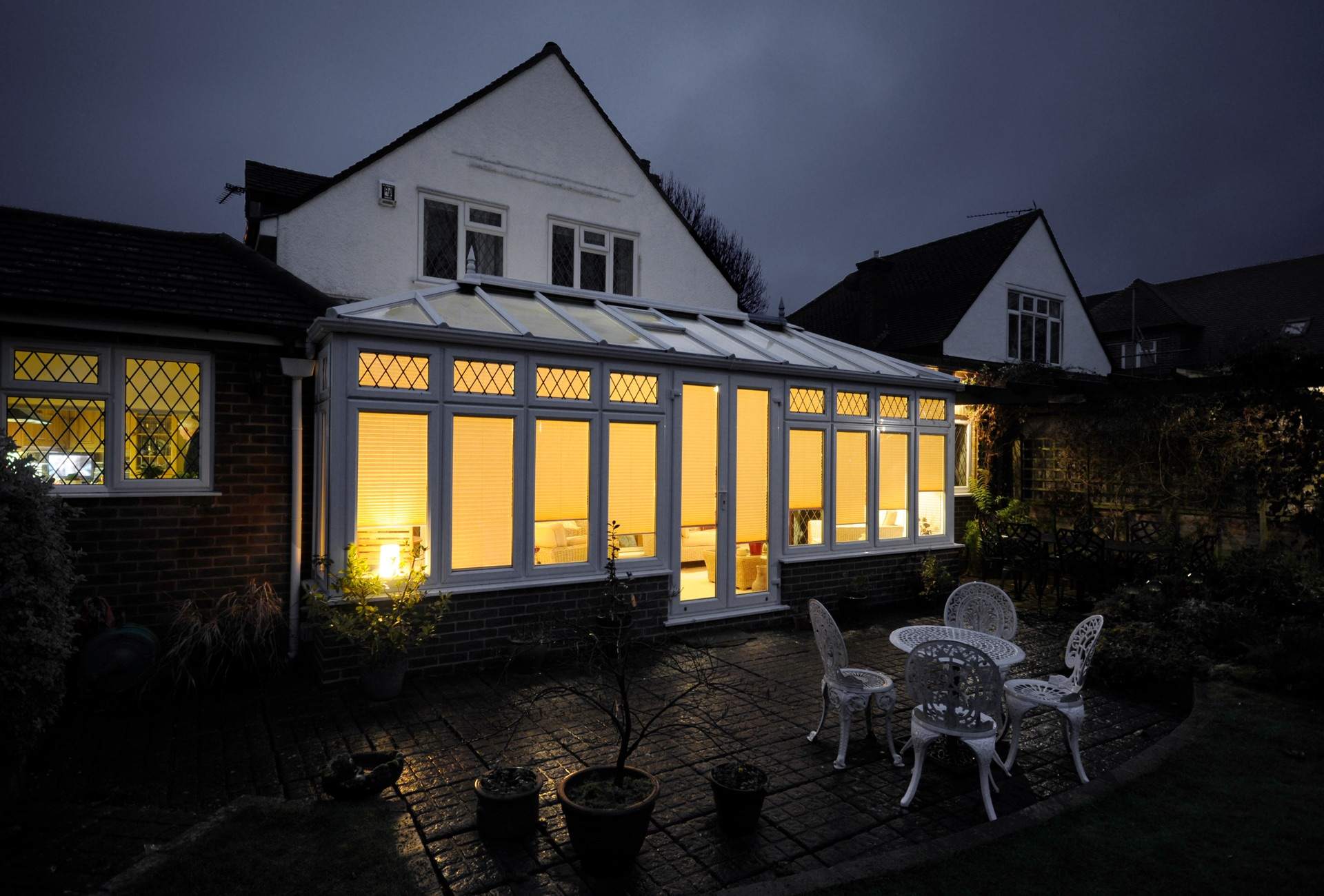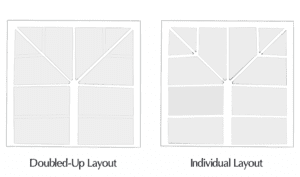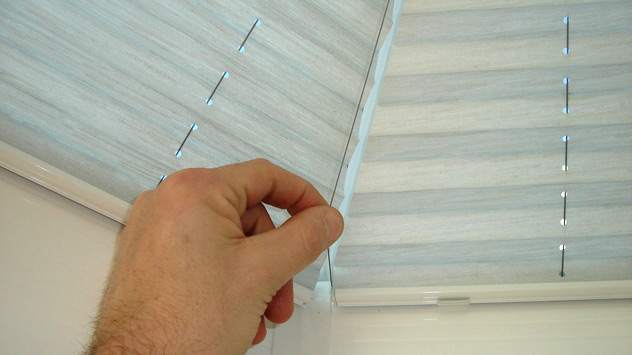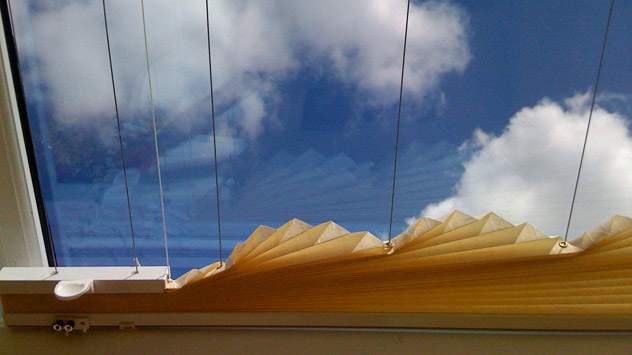TECHNICAL QUESTIONS AND ADVICE
Click the questions to view the answers.
The “wires” in a roof blind actually vary in type and construction depending on which range of blinds you are referring to.
The “wires” on our pure™ Pleated Blinds are actually 0.9mm diameter stainless steel micro-cables that are polymer coated and silicone impregnated to protect them and provide a smooth operation.
A rectangular roof blind requires an absolute minimum of 2 supporting micro-cables and (for instance) a rectangular pinoleum blind should not need a third micro-cable until approx. 750mm wide x 3500mm long (2’6″ x 11’6″).
Shaped blinds require more micro-cables than rectangular blinds so that they support the shaped edge of the fabric. View our image gallery to see how this can vary.
The answer depends on what colour rails you have selected, the colour of your fabric and the colour of your conservatory.
In general terms; we normally recommend grey silicone impregnated stainless steel micro-cables for darker coloured fabrics and brown coloured conservatories, with white micro-cables for pale coloured fabrics in light-coloured conservatories.
Black micro-cables are also available but are rarely used, except on black fabrics.
Even this is not a complete answer as there are so many variables. Always seek our advice and, if necessary, we can even create a small sample fabric with cord/micro-cable combination for you to see beforehand.
But beware; looking at a small sample can be misleading – you need to envisage it in a much larger scale where the proportion of fabric is so much greater than on a small sample, where the micro-cables seem more obvious than they really are.
We always discuss this with you at survey and confirm the colour selected.
Yes, we offer a wide range of blinds for every different type of requirement, as well as to suit all of the different forms of glazing available in conservatories.
We have high performance fabrics with solar reflective properties of up to 85%, or even specialist Duette® fabrics that stop any solar transmission through the fabric altogether.
But by far the most popular are our pure™ range of fabrics that are not only specifically designed to be safe to use with all forms of modern solar glass, but will also significantly reduce solar heat gain, UV transmission and glare whilst increasing thermal insulation against heat loss during the winter – all without darkening your conservatory and adjoining room.
No, the performance figures supplied by fabric manufacturers are theoretical and are NOT tested in a conservatory, nor are they tested using the same type of glazing.
This is the true of all fabrics from all manufacturers whoever you buy your blinds from.
We provide genuine expert advice based on many years of empirical evidence of what fabrics are best suited to differing conditions, which is another reason to only deal with a genuine conservatory blinds specialist, rather than a general retailer or direct sales company.
Yes, we are able to offer unique obtuse roof blinds that are completely operational.
Obtuse triangles are now quite common in conservatory roofs. They have a base angle that exceeds 90 degrees, resulting in the triangle sloping “backwards” away from the base. The more obtuse the angle is, the more difficult it is for it to look neat.
Our obtuse blinds are very different from those made by other companies.
All blinds are bespoke-manufactured to suit the conservatory in which they are being installed, so there are no fixed specifications, but you can read below to find out more.
Tinted roofs are available with different colours to filter different parts of the sun’s spectrum, but are often aimed at reducing the heat that enters the conservatory.
That being the case, you need to ensure that your roof blinds won’t cause excessive heat build up between the fabric and the roof glazing by being too thick, impermeable or solar reflective. The main conservatory roof manufacturers also stipulate that you should have an individual blind layout with a 15mm air gap.
Without specific knowledge of any glazing, roof construction or ventilation, we would normally only recommend pure™ Pleated Blinds, pure™ Pinoleum Blinds or pure™ Roman Blinds because they have been specifically designed for UK conservatories and have highly suitable Solar Reflective Fabrics.
Maximum blind sizes vary with blind type, range, shape and roof pitch. Nevertheless the following maximum blind sizes are a good rule of thumb for pleated roof blinds.
| SHAPED ROOF BLINDS | RECTANGULAR ROOF BLINDS | |||
| Width | Drop | Width | Drop | |
| Minimum: | 250mm | 250mm | 150mm | 100mm |
| Maximum: | 1800mm | 4500mm | 1800mm | 5000mm |
| Recommend: | 1600mm | 4000mm | 1400mm | 4500mm |
For specific technical advice please contact us.
Perfect Fit blinds are fitted by a series of steel clips that are pushed between the neoprene gasket and glass of an internally beaded UPVC window.
These clips come in different sizes from 18-24mm deep. If your bead is less than 18mm deep then there is a self-adhesive foam strip that can be used to pack out the gap.
However, often when a bead is less than 18mm deep it is because the window is externally beaded and what you are measuring internally is the frame of the window.
If in doubt please send us a message, or if you want to send us a photograph you can contact us by email.
Whilst we have always offered the option of aluminium backed fabrics, they are increasingly unsuitable to modern conservatories and we strongly advise against them in conjunction with solar glass or high-performance roof glazing.
Some retailers selling what they claim to be “conservatory blinds” (but are most definitely not) only offer aluminium-backed fabrics – probably because they are much cheaper.
The main reason that we do not recommend aluminium backed fabrics is because of the extreme heat build-up behind the fabric.
If you use aluminium backed blinds then the highly reflective surface traps the heat behind the blind which cannot escape back through the glass (before K-Glass was introduced in 2002 the heat would simply reflect back out). This is the main issue that roof manufacturers have with these blinds, as this super-heated air can cause the UPVC rafters and neoprene gasket to overheat.
Many roof manufacturers and conservatory builders have even gone to the extremes of trying to stipulate how blinds should be fitted because of this in an effort to limit their guarantee.
The other downsides with aluminium backed fabrics (regardless of glazing) are:
Aluminium backed fabrics are not washable
They can be wiped, but would not stay looking “like new” as we can with our pure™ Pleated Blinds.
Aluminium backed fabrics are very shiny
The aluminium back is very shiny and obvious from outside (when the blinds are extended) or inside when shaped blinds are retracted (you can see the contrast along the cut edge).
Aluminium backed fabrics can oxidise
Unless the fabric is laminated with a plastic coating then condensation or insects that decompose on it can oxidise and create tiny (pinprick sized) burn holes through the fabric.
Aluminium backed fabrics can cause condensation
If the fabric is laminated with a plastic coating then it cannot breathe – this means that condensation can form on it if there is insufficient ventilation.
Aluminium backed fabrics cut down a lot of light
Aluminium backed fabrics significantly reduce natural light compared to our pure™ Pleated Blinds, which have specifically been designed for use with solar glazing. The Solar Design™ fabrics within our pure™ Pleated Blinds allow you to have your blinds extended without making your conservatory or adjoining rooms too dark.
Aluminium backed fabrics require more hardware in a blind
Because aluminium backed fabrics are thicker and more “springy” they stack deeper when the blind is retracted and requires extra rails to be fitted to some shapes to hold it in position. In other words it is not as neat.
For more information, contact us for free technical advice and to compare fabrics in your own conservatory.
If you have a UPVC conservatory with solar glazing and are looking for the best blinds that are most suitable to your roof then we would recommend our unique range of pure™ Pleated Blinds because they are specifically designed for modern UK conservatories with solar glass.
The latest forms of solar glazing reduce heat by absorption and reflection, so the glass gets very hot (touch the roof glazing on a sunny day to see just how hot).
Roof manufacturers normally insist that roof blinds have an individual layout (where you don’t have oversized blinds covering more than one pane of glass) with a 15mm air gap at the edges (which we achieve without creating an extra light gap) because they are conscious of the possibility of heat build-up behind the blind, despite the higher performance glazing and eaves vents that they fit.
If you use thick or aluminium-backed blinds then the highly reflective surface traps the heat behind the blind which cannot escape back through the glass (before K-Glass was introduced in 2002 the heat would simply reflect back out). This is the main issue that roof manufacturers have with certain blinds, as this super-heated air can cause the UPVC rafters and neoprene gasket to overheat.
To give you an idea of just how hot it can get behind the wrong specification blinds: polycarbonate roofs can be scorched to the point where they require replacement and we have even come across installations where the blinds that we are replacing have become so hot that they cannot be held with bare hands.
For more information browse our Image Gallery by blind type, conservatory shape and structure. There are hundreds of images with explanations of what blinds have been installed and why they are recommended.
If you have a shaped conservatory then you almost certainly have a central boss (sometimes referred to as a crown moulding). It is the “capping” that covers the point where all the shaped rafters meet in the roof.
It is called a boss because that’s the term used for the central cover of a wheel hub (if you look at the plan of a shaped conservatory roof it often looks like the spokes of a wheel radiating out from a central point).
This part of a conservatory is very important when considering blinds because it can often be the cause of ugly gaps, if not done correctly. Things to consider are:
How narrow can shaped blinds be made at the very top?
The top of a shaped blind cannot be made to a point, so it all depends on how narrow (or wide) the apex width at the top of the blind would be.
Our pure™ Pleated Blinds can be made much narrower than any other shaped roof blind (with an apex width of just 59mm) so this tends to overcome any issues and makes them the roof blinds of choice. Most other roof blinds require a 100mm shaped top, so they tend to leave large gaps.
Is your boss the same shape as the eaves of your roof?
A lot of conservatories have a different shaped boss from the actual roof. As the top of a shaped blind is flat and must be parallel to the base of the blind then, if the boss has a different shape, then there will be unavoidable gaps.
Having said that, these gaps are normally tiny and almost invisible, and even if they aren’t then they can be filled with UPVC, but this cannot be guaranteed to last.
Does the boss intrude over adjacent glazing?
If the boss is very big it may overlap well past the junction of the shaped rafters and start to cover the adjacent glazing. If this happens, then the adjacent blind cannot be cut around this, leaving just two options:
Replace the boss – not many people are willing to do this but it is by far the best option
Create an infill blind – this is the most common option and can be extremely neat
Search our conservatory blinds image gallery to see just how neatly our blinds fit compared to all others.
An individual blind layout means that you have one blind per pane of glass, as opposed to a larger blind covering multiple panes of glass. This could refer to window blinds or, more commonly, roof blinds.
You will probably find that most, if not all, blind retailers will assume a ‘doubled-up’ layout (where one big blind covers more than one pane of glass) as it is normally much cheaper.
This is especially true if you are considering remote control conservatory blinds, not only because big blinds are cheaper but, as there are fewer blinds required, there will be far fewer motors.
Although individual blinds are normally more expensive, they have many advantages:
UPVC Roofs: If you have a UPVC conservatory roof built within the last 3 years, particularly if you have an Ultraframe, Anglian or Everest conservatory, then the guarantee will stipulate that you MUST have an individual blind layout with a 15mm air gap so that the space between the blinds and the roof glazing does not overheat.
Timber Roofs: If you have a timber conservatory then the rafters will probably be quite deep (often between 100-200mm). Individual blinds would be recess-fitted between the rafters, making it look much neater.
Appearance: An individual blind layout nearly always looks more attractive as they respect the shape of the structure. The blinds look like are part of the conservatory. Large blinds tend to smother the conservatory; they lose the shape of the conservatory and can, quite often, even appear cheap.
Height: Unless you have a very large conservatory with very generously proportioned glazing and a tall eaves height, fitting the blinds well below the rafters makes the conservatory feel much more closed-in. In some cases this is completely true – it does reduce the head height dramatically, but in other cases it is simply the impression it creates. Individual blinds tend to make the conservatory feel taller.
Small Conservatories: An individual blind layout within a small conservatory makes all the difference. Compare a doubled-up blind layout and a small conservatory will feel much smaller, compared to an individual blind layout.
Individual blinds are not always the correct solution – it very much depends on the conservatory shape, construction, glazing and size, as well as the specific blind type required and your own personal taste.
A doubled-up blind layout is the opposite of an individual blind layout. It means that you have one large blind covering multiple panes of glass, as opposed to one blind per pane. This could refer to window blinds or, more commonly, roof blinds.
You will probably find that most (if not all) blind retailers will assume a ‘doubled-up’ layout in any quotation (probably without even telling you) as it is normally much cheaper than an individual blind layout.
This is especially true if you are considering remote control operation because not only are big blinds cheaper, but this will significantly reduce the number of blinds (and therefore motors) required.
Although individual blinds are normally recommended, this varies with requirements:
UPVC Roofs: Unless you have a UPVC conservatory roof built within the last 3 years, then you can normally have a doubled-up blind layout without any concern. It is only if your roof guarantee stipulates individual blinds with a 15mm air gap that you should avoid a doubled-up blind layout.
Timber Roofs: If you have a modular timber conservatory with deep main rafters but smaller jack rafters (which you often find on Amdega conservatories for instance) then doubled-up blinds are perfect (especially common with pinoleum blinds). Individual blinds would be recess-fitted between the narrow rafters, which may look wrong unless you have Pure Pleated Blinds (because only they can be made that narrow).
Appearance: A doubled-up blind layout often looks more attractive in very large conservatories, with well-proportioned shapes, especially pinoleum blinds, roman blinds and roller blinds.
Height: If you have a very tall conservatory, with a lot of headroom, then doubled-up roof blinds can create a more homely feel. Individual blinds tend to make the conservatory feel even taller.
Small Conservatories: The one situation where all the above should be ignored is in a small conservatory. Doubled-up blinds are rarely a good idea in a small conservatory as they tend to make the space seem even more closed-in.
Doubled-up blinds are not often the best solution for conservatories, but it very much depends on the conservatory shape, construction, glazing and size, as well as the specific blind type required and your own personal taste.
Fabric Control Cording (or FCC for short) is a key part of a shaped pleated roof blind. It runs a lightly tensioned thin “lay flat” cord along the shaped edge to help hold the blind in shape when it is extended and also holds the fabric flatter when the blind is retracted.
This “lay flat” cord is routed through the specially designed end caps and is held under light tension by a specially designed custom spring. Unlike many blinds, pure™ Pleated Blinds can have Fabric Control Cording on all shaped blinds, including awkward shaped blinds and all motorised blinds.
As a consequence of Fabric Control Cording along the shaped edge of a blind, the slight force exerted means that the blind would distort on the opposite edge, which is negated by specially designed cords for equalised pleating. This holds the blind in shape across its width and along its length.
The unique way that we design our pure™ Pleated Blind system is often mimicked in other cheap blinds, but never works the same, as you can see in the following image of blinds fitted by another company.
Recessed or recess-fitted blinds normally refers to blinds fitted between the glazing beads of a window, more or less right up to the glass, leaving the window frames entirely visible.
It also refers to roof blinds that are fitted between the rafters of a conservatory roof (normally timber rafters, but this is also possible with deep beamed UPVC and aluminium conservatories).
Whilst it is technically possible to recess-fit virtually any pleated blind, if the recess is deep enough and relatively flat, most conservatories do not provide such an easy fit nowadays.
For most modern conservatories we recommend a purpose-designed conservatory blinds range (in other words a range of blinds that was always intended for recess-fitting) with rails that can accommodate awkward shaped glazing beads (as in almost all modern UPVC conservatories).
Surface mounted blinds are the opposite of recessed or recess-fitted blinds. They are blinds that are fitted to the face of a window/wall or fitted below any roof rafters.
Blinds are normally surface mounted for 4 main reasons:
- There is not enough depth to have recess-fitted blinds
- Having recess-fitted blinds would compromise appearance/operation
- Surface mounted blinds would look/operate much better
- Surface mounted blinds can be doubled-up to reduce cost










